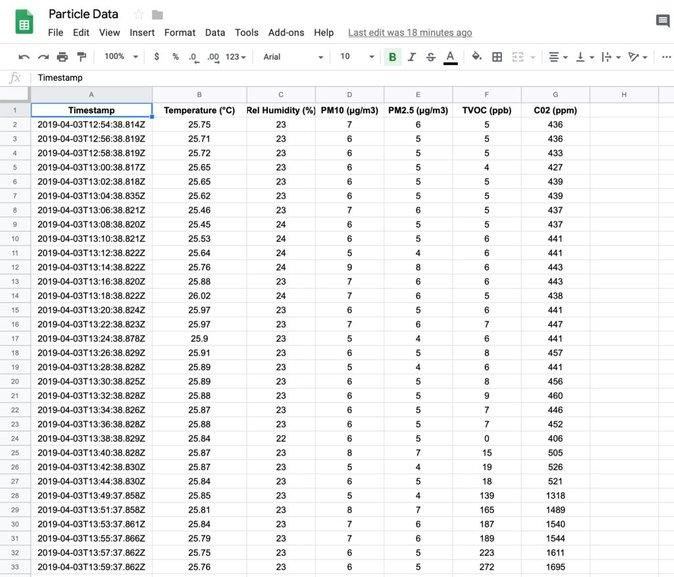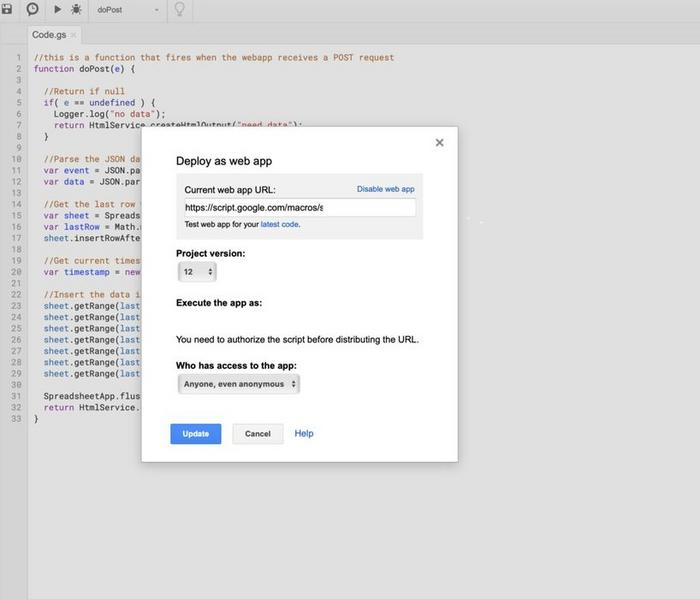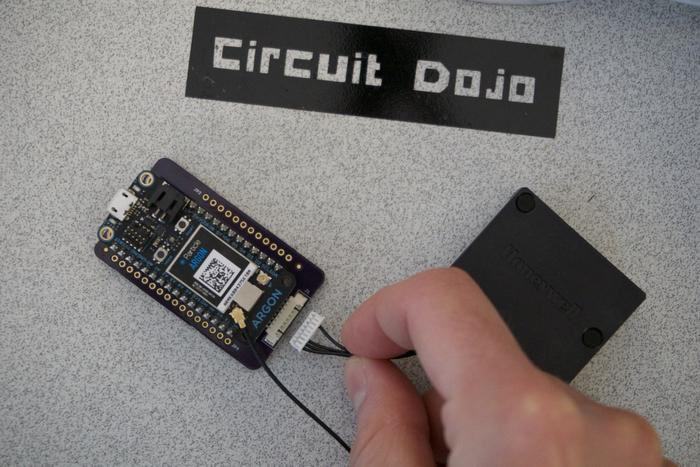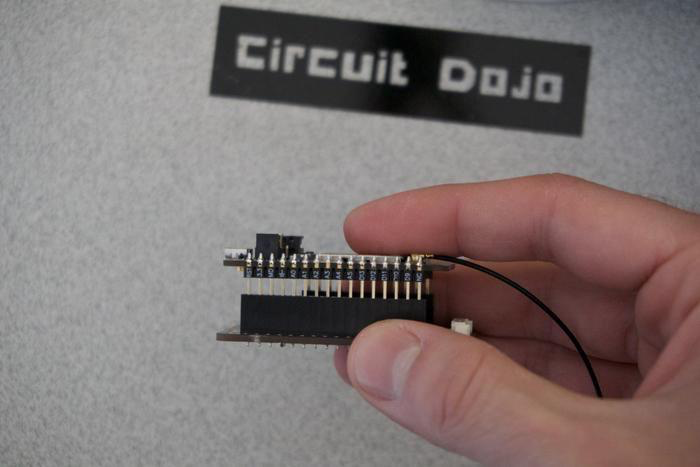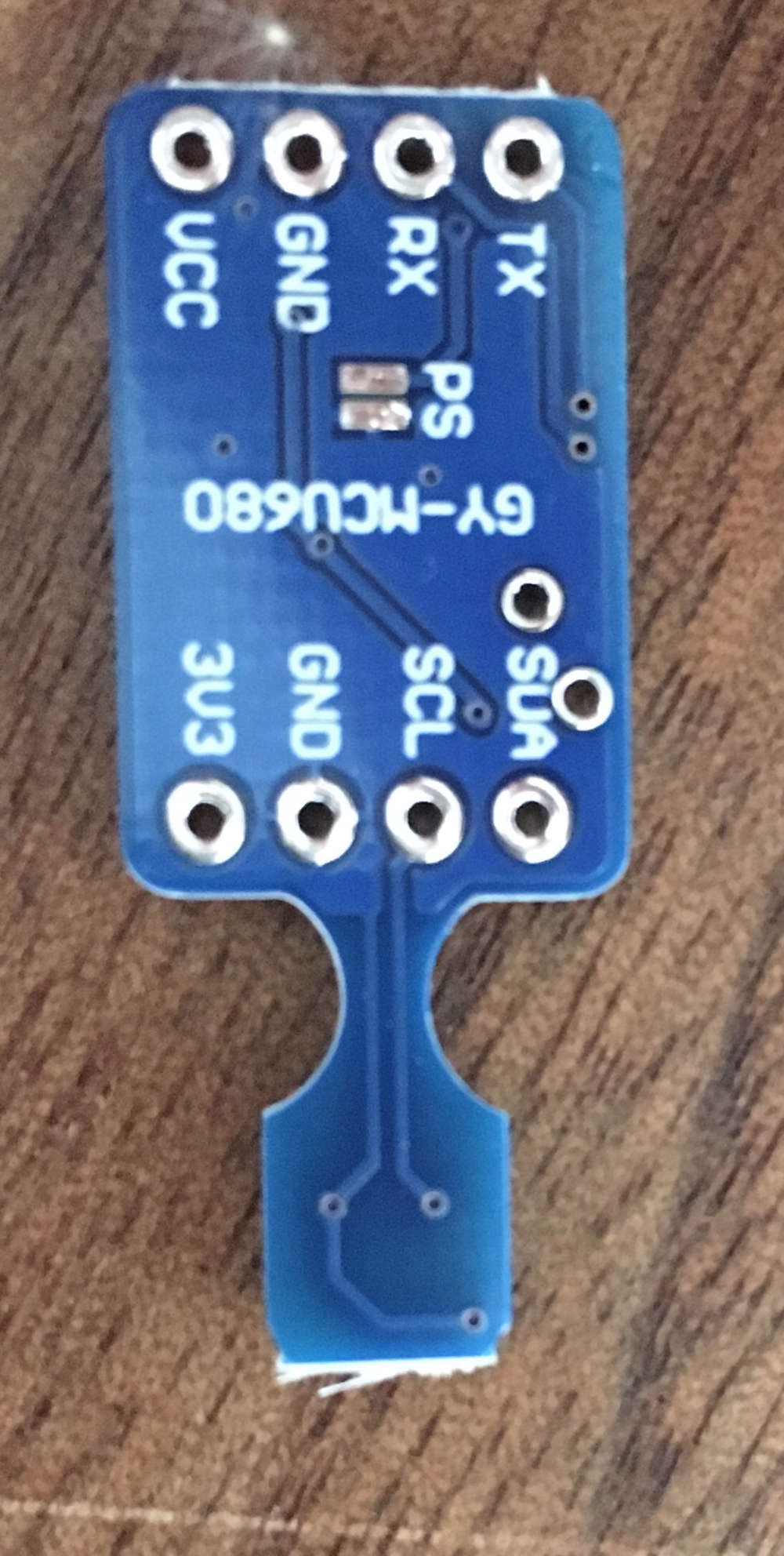Particle Powered Air Quality Sensor Logging to Google Docs
-
Firmware upgrade time!
My CCS811 has bootloader version: 1000
and had application version: 1100
I upgraded to the newest firmware (2.0.1). Now waiting for another two days.... :) Hope then I get reasonable results like you have....
@fotofieber yeehaw. I hope that fixes the craziness you were seeing. I'm curious if that will fix the early unreliable data I've been seeing too..
-
@FotoFieber if you check out my
tvoc_testbranch, I implemented the CCS811 update routine. I'm interested to see how it compares to the SPG30 and BME680.. -
@FotoFieber if you check out my
tvoc_testbranch, I implemented the CCS811 update routine. I'm interested to see how it compares to the SPG30 and BME680..@jaredwolff
The update has brought a big improvement.
I think one could derive airquality from the measurements, but the CO2 ppm value is still way off.
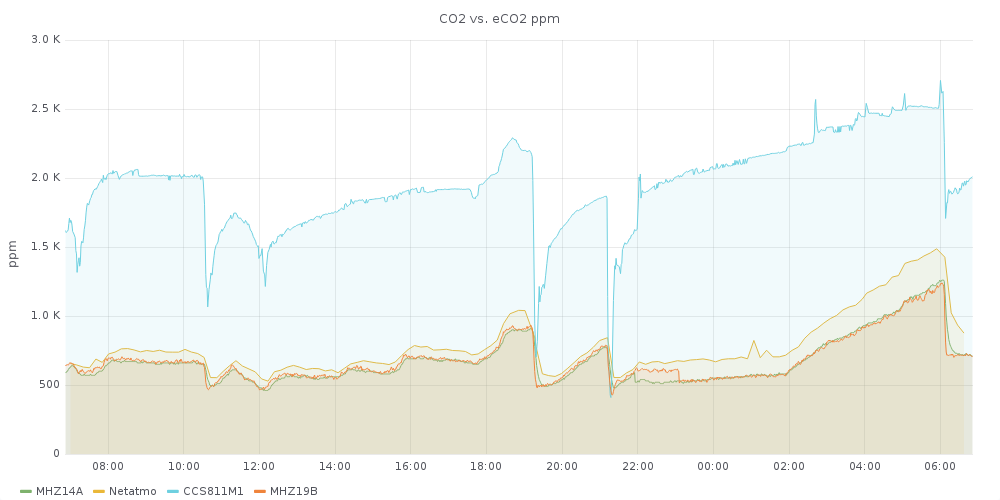
-
@jaredwolff
The update has brought a big improvement.
I think one could derive airquality from the measurements, but the CO2 ppm value is still way off.

@fotofieber that's great news! Pretty much what I've seen. I've stopped eC02 all together because it correlates 1:1 with TVOC on that part. Plus I don't know how actionable the C02 reading is. Does it indicate stale air? C02 is a byproduct of the VOCs? Maybe it's more useful for more industrial environments..
Are you logging anything other than C02?
-
@fotofieber that's great news! Pretty much what I've seen. I've stopped eC02 all together because it correlates 1:1 with TVOC on that part. Plus I don't know how actionable the C02 reading is. Does it indicate stale air? C02 is a byproduct of the VOCs? Maybe it's more useful for more industrial environments..
Are you logging anything other than C02?
@jaredwolff
CO2 is an indicator of air quality. I use it since years mainly with consumer devices from Netatmo. In my graphs you can see, when people are in the rooms consume the air, when they leave, when I open the windows...The CO2 measurement with NDIR-sensors seems much more reliable than what I see here from CCS811. They usually show quite good results just plugged in without calibration. They are easier to handle, because you don''t need to bother with handling basline (save and restore). And they don't need a temp/hum measurement to correct their values.
Yesterday arrived another NDIR-Sensor (Senseair S8) and a SGP30. I am curious, how they perform. Hope I have the first results in two days.
Are you logging anything other than C02?
In general I have much more values I log (radioactivity, luminosity, window open/close, motion...)
In this setup I log what I can get from the sensors.
-
@jaredwolff
CO2 is an indicator of air quality. I use it since years mainly with consumer devices from Netatmo. In my graphs you can see, when people are in the rooms consume the air, when they leave, when I open the windows...The CO2 measurement with NDIR-sensors seems much more reliable than what I see here from CCS811. They usually show quite good results just plugged in without calibration. They are easier to handle, because you don''t need to bother with handling basline (save and restore). And they don't need a temp/hum measurement to correct their values.
Yesterday arrived another NDIR-Sensor (Senseair S8) and a SGP30. I am curious, how they perform. Hope I have the first results in two days.
Are you logging anything other than C02?
In general I have much more values I log (radioactivity, luminosity, window open/close, motion...)
In this setup I log what I can get from the sensors.
This night was a complete fail for the CCS811 I have here:
Fresh air at 20:00
Sleep till 6:15 with closed windows
-> NDIR sensors show, how air quality gets worse
-> CCS811 shows, how the air quality gets better during sleep with closed window!
Fresh air at 06:15WTF.... :)
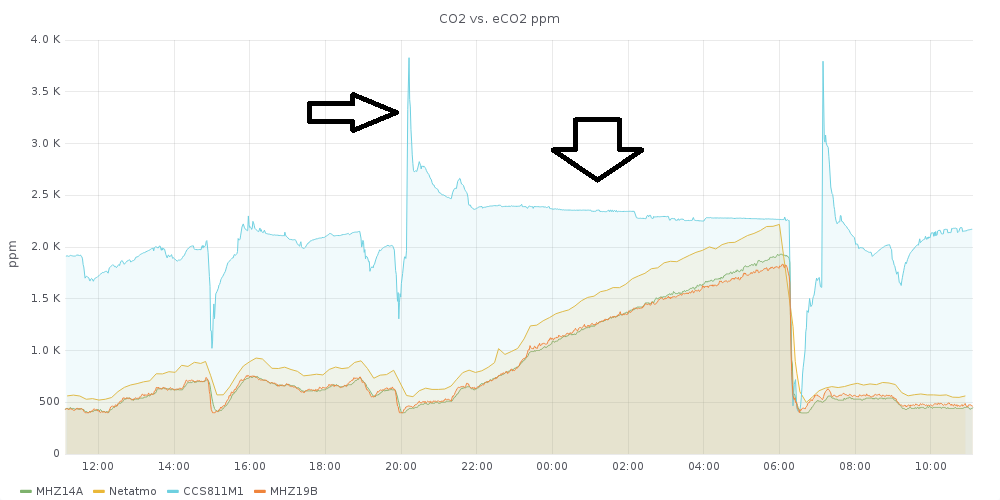
-
@jaredwolff
CO2 is an indicator of air quality. I use it since years mainly with consumer devices from Netatmo. In my graphs you can see, when people are in the rooms consume the air, when they leave, when I open the windows...The CO2 measurement with NDIR-sensors seems much more reliable than what I see here from CCS811. They usually show quite good results just plugged in without calibration. They are easier to handle, because you don''t need to bother with handling basline (save and restore). And they don't need a temp/hum measurement to correct their values.
Yesterday arrived another NDIR-Sensor (Senseair S8) and a SGP30. I am curious, how they perform. Hope I have the first results in two days.
Are you logging anything other than C02?
In general I have much more values I log (radioactivity, luminosity, window open/close, motion...)
In this setup I log what I can get from the sensors.
S8 readings seem quite goot. (NDIR)
SGP30 :( Will try with the adafruit library instead of the sparktech.

-
S8 readings seem quite goot. (NDIR)
SGP30 :( Will try with the adafruit library instead of the sparktech.

@fotofieber said in Particle Powered Air Quality Sensor Logging to Google Docs:
SGP30 Will try with the adafruit library instead of the sparktech.
I have that one in the same branch I mentioned before if you need a working reference.
I followed your lead on the Grafana + InfluxDB stuff. It was dead simple to setup.

I just want to get HTTPS/SSL working. Pretty nifty little piece of software. :)
-
@fotofieber said in Particle Powered Air Quality Sensor Logging to Google Docs:
SGP30 Will try with the adafruit library instead of the sparktech.
I have that one in the same branch I mentioned before if you need a working reference.
I followed your lead on the Grafana + InfluxDB stuff. It was dead simple to setup.

I just want to get HTTPS/SSL working. Pretty nifty little piece of software. :)
@jaredwolff said in Particle Powered Air Quality Sensor Logging to Google Docs:
I followed your lead on the Grafana + InfluxDB stuff. It was dead simple to setup.
Yes, really simple. I use docker for grafana and influxdb.
Your SGP30 CO2 ppm graph looks like mine... :(
I just want to get HTTPS/SSL working.
I use an nginx-setup here for https.
Pretty nifty little piece of software.
Yepp! They are real software gems.
-
@jaredwolff said in Particle Powered Air Quality Sensor Logging to Google Docs:
I followed your lead on the Grafana + InfluxDB stuff. It was dead simple to setup.
Yes, really simple. I use docker for grafana and influxdb.
Your SGP30 CO2 ppm graph looks like mine... :(
I just want to get HTTPS/SSL working.
I use an nginx-setup here for https.
Pretty nifty little piece of software.
Yepp! They are real software gems.
@fotofieber also, I compiled my conclusions about some of the smaller form factor TVOC/C02 sensors. It was inspired by everything we talked about here. Our back and forth conversation has been awesome. So I wanted to say thanks for the inspiration :)
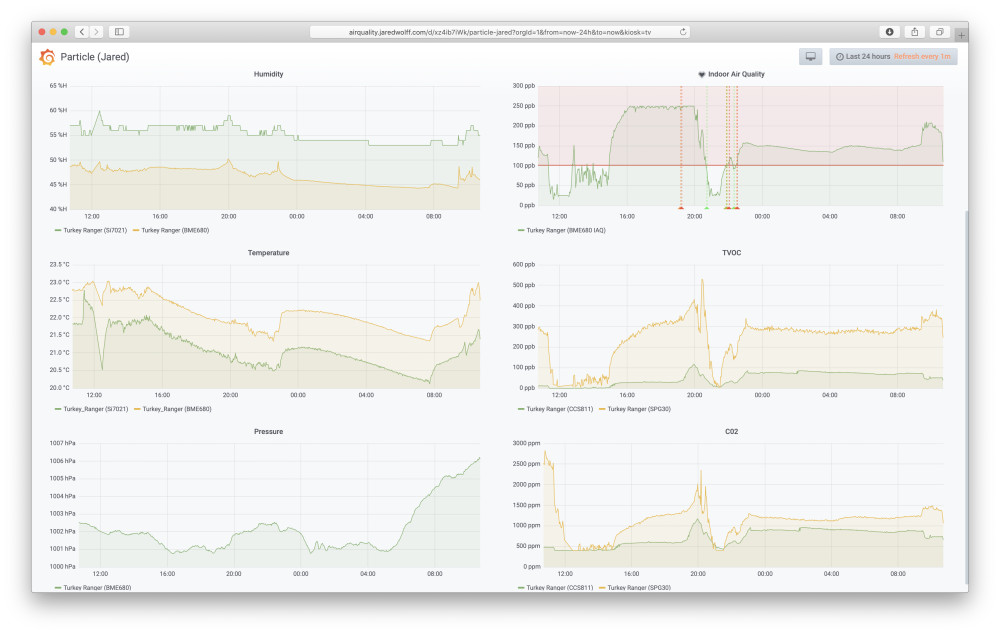
The above is a screenshot from the side-by-side data of the BME680, CCS811 and SGP30.
The BME680 seemed impressive at first but I'm seeing a big difference in temperature and humidity. My thinking it's likely due to the heating elements inside keeping it a little less humid and a little more hot. (These are the compensated values by the way. The non-compensated values are even lower humidity and a hotter.)
The SGP30 is a bit of a power hog but the TVOC readings seemed to align well with the response from the BME680.
The CCS811, like we've seen throughout this thread, had some wacky responses using the 1.0.0 firmware. I haven't seen that since all of my CCS811 are up to date.
It's a toss up between all three but I'd shy away from the CCS811. If anyone here plans on building a production device, the stock is not reliable enough. (Digikey and Mouser have been out of stock lately) I'm not sure if you'd have the same problem in the EU or how things are in Asia.
Anyway my TLDR conclusions are here if anyone is interested. They include software implementation factors, hardware factors, availability factors and data output factors all rolled into one.
-
@jaredwolff said in Particle Powered Air Quality Sensor Logging to Google Docs:
I followed your lead on the Grafana + InfluxDB stuff. It was dead simple to setup.
Yes, really simple. I use docker for grafana and influxdb.
Your SGP30 CO2 ppm graph looks like mine... :(
I just want to get HTTPS/SSL working.
I use an nginx-setup here for https.
Pretty nifty little piece of software.
Yepp! They are real software gems.
@fotofieber said in Particle Powered Air Quality Sensor Logging to Google Docs:
Your SGP30 CO2 ppm graph looks like mine...
Also, Is your SGP30 plot the dark red one? Definitely not what I'd expect from this sensor. At first I thought it was the CCS811 as that one appears to be less reactive (at least in my testing)
-
@fotofieber also, I compiled my conclusions about some of the smaller form factor TVOC/C02 sensors. It was inspired by everything we talked about here. Our back and forth conversation has been awesome. So I wanted to say thanks for the inspiration :)

The above is a screenshot from the side-by-side data of the BME680, CCS811 and SGP30.
The BME680 seemed impressive at first but I'm seeing a big difference in temperature and humidity. My thinking it's likely due to the heating elements inside keeping it a little less humid and a little more hot. (These are the compensated values by the way. The non-compensated values are even lower humidity and a hotter.)
The SGP30 is a bit of a power hog but the TVOC readings seemed to align well with the response from the BME680.
The CCS811, like we've seen throughout this thread, had some wacky responses using the 1.0.0 firmware. I haven't seen that since all of my CCS811 are up to date.
It's a toss up between all three but I'd shy away from the CCS811. If anyone here plans on building a production device, the stock is not reliable enough. (Digikey and Mouser have been out of stock lately) I'm not sure if you'd have the same problem in the EU or how things are in Asia.
Anyway my TLDR conclusions are here if anyone is interested. They include software implementation factors, hardware factors, availability factors and data output factors all rolled into one.
@jaredwolff said in Particle Powered Air Quality Sensor Logging to Google Docs:
The BME680 seemed impressive at first but I'm seeing a big difference in temperature and humidity. My thinking it's likely due to the heating elements inside keeping it a little less humid and a little more hot. (These are the compensated values by the way. The non-compensated values are even lower humidity and a hotter.)
I have tested several temperature sensors in the same setup and will use seperate HTU21D in my production devices anyway. So temperature and humidity would be no problem for me.
@jaredwolff said in Particle Powered Air Quality Sensor Logging to Google Docs:
Also, Is your SGP30 plot the dark red one? Definitely not what I'd expect from this sensor. At first I thought it was the CCS811 as that one appears to be less reactive (at least in my testing)
Yes, it's is the dark red one. :(
Yesterday another CCS811 arrived. I will add it to my setup.My final setup drifts to:
- HTU21D temp/hum
- MHZ19B CO2
- HC-SR501 (modified for 3.3V) motion
- WS 2812B led stripes
-
@jaredwolff said in Particle Powered Air Quality Sensor Logging to Google Docs:
The BME680 seemed impressive at first but I'm seeing a big difference in temperature and humidity. My thinking it's likely due to the heating elements inside keeping it a little less humid and a little more hot. (These are the compensated values by the way. The non-compensated values are even lower humidity and a hotter.)
I have tested several temperature sensors in the same setup and will use seperate HTU21D in my production devices anyway. So temperature and humidity would be no problem for me.
@jaredwolff said in Particle Powered Air Quality Sensor Logging to Google Docs:
Also, Is your SGP30 plot the dark red one? Definitely not what I'd expect from this sensor. At first I thought it was the CCS811 as that one appears to be less reactive (at least in my testing)
Yes, it's is the dark red one. :(
Yesterday another CCS811 arrived. I will add it to my setup.My final setup drifts to:
- HTU21D temp/hum
- MHZ19B CO2
- HC-SR501 (modified for 3.3V) motion
- WS 2812B led stripes
@fotofieber said in Particle Powered Air Quality Sensor Logging to Google Docs:
I have tested several temperature sensors in the same setup and will use seperate HTU21D in my production devices anyway. So temperature and humidity would be no problem for me.
After someone on a different forum suggested, I actually switched it from continuous to low power mode and the temperature and humidity readings look better.
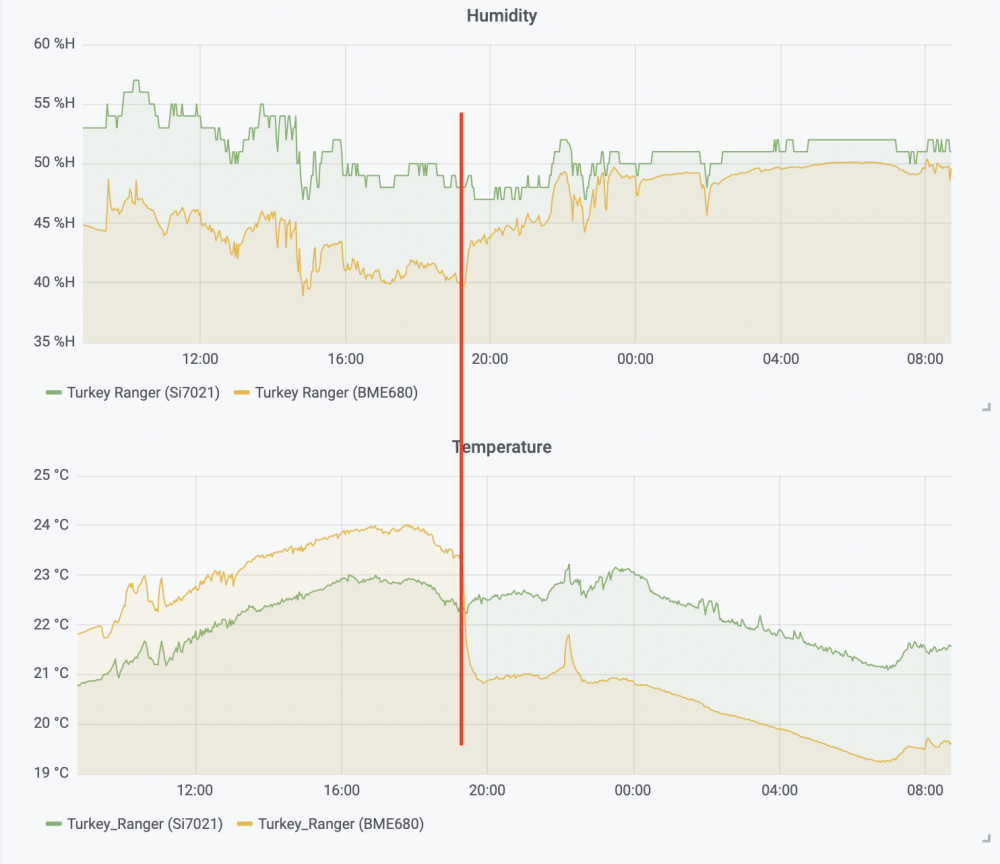
(Red line is in the middle between before and after the change.)
@fotofieber said in Particle Powered Air Quality Sensor Logging to Google Docs:
Yesterday another CCS811 arrived. I will add it to my setup.
Nice, curious to see your results!
-
@fotofieber said in Particle Powered Air Quality Sensor Logging to Google Docs:
I have tested several temperature sensors in the same setup and will use seperate HTU21D in my production devices anyway. So temperature and humidity would be no problem for me.
After someone on a different forum suggested, I actually switched it from continuous to low power mode and the temperature and humidity readings look better.

(Red line is in the middle between before and after the change.)
@fotofieber said in Particle Powered Air Quality Sensor Logging to Google Docs:
Yesterday another CCS811 arrived. I will add it to my setup.
Nice, curious to see your results!
BME680 sensor mith MCU arrived. Hope I can read the chinese specification of the module.... :) (What stand PS for?)
-
BME680 sensor mith MCU arrived. Hope I can read the chinese specification of the module.... :) (What stand PS for?)
@fotofieber hmm I'm not sure. Can you send me more info about the board you got?
-
@fotofieber hmm I'm not sure. Can you send me more info about the board you got?
@jaredwolff
Found something on https://de.aliexpress.com/item/GY-MCU680V1-BME680-Sensor-Module-Temperature-and-Humidity-Air-Pressure-Air-Quality-IAQ-MCU680-Module/32902672818.html?spm=a2g0x.10010108.1000016.1.3bc92080ZxA8fs&isOrigTitle=trueWhen soldering the PS solder joint, the module is in the chip's own IIC mode, at which point the MCU does not participate in the operation and does not consume current. Can be used as a simple BME680 module.
And in serial mode:
https://playground.cmmakerclub.com/2018/12/esp32/วิธีการใช้งาน-gy-mcu680-กับ-esp32/I will try the I2C mode first.
-
@jaredwolff
Found something on https://de.aliexpress.com/item/GY-MCU680V1-BME680-Sensor-Module-Temperature-and-Humidity-Air-Pressure-Air-Quality-IAQ-MCU680-Module/32902672818.html?spm=a2g0x.10010108.1000016.1.3bc92080ZxA8fs&isOrigTitle=trueWhen soldering the PS solder joint, the module is in the chip's own IIC mode, at which point the MCU does not participate in the operation and does not consume current. Can be used as a simple BME680 module.
And in serial mode:
https://playground.cmmakerclub.com/2018/12/esp32/วิธีการใช้งาน-gy-mcu680-กับ-esp32/I will try the I2C mode first.
@fotofieber I'm using I2C over here with great success. Let me know how it goes!
-
@fotofieber I'm using I2C over here with great success. Let me know how it goes!
@jaredwolff
Seems like I only get an IAQ value for the BME680 and no (e)CO2. Is this correct? -
@jaredwolff
Seems like I only get an IAQ value for the BME680 and no (e)CO2. Is this correct?@fotofieber correct! No C02. There's also temp, humidity and pressure. Here's a little code to get up and running with their C++ library.
-
@fotofieber correct! No C02. There's also temp, humidity and pressure. Here's a little code to get up and running with their C++ library.
@jaredwolff
Managed to compile Bosch arduino demo code on ESP32 on platformio after 3 hours. :sunglasses:But then....
BSEC library version 1.4.7.3 Timestamp [ms], raw temperature [°C], pressure [hPa], raw relative humidity [%], gas [Ohm], IAQ, IAQ accuracy, temperature [°C], relative humidity [%], Static IAQ, CO2 equivalent, breath VOC equivalent BSEC error code : -2Maybe I give up here, as I really don't like to use binary code in my sensors....



